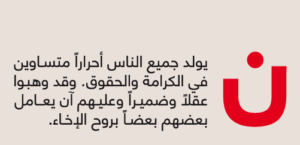By Marwa Gadallah
If you were becoming an Arabic type designer, one of the things you would need to consider, oddly enough, is Latin type design: much Arabic type design involves creating Arabic counterparts to existing Latin typefaces, a process known as typographic matchmaking. The Arabic script was incorporated into printing technology –outside of Arabophone contexts for the purposes of those who studied Islam for both academic and polemic purposes– roughly a century after the Latin script: Gutenberg, the inventor of Latin movable type, didn’t design printing with the Arabic script in mind. Arabic is composed of 28 letters, which have four letterforms (isolated, initial, medial and final forms), thus requiring a large number of type pieces to be created and the process was time-consuming. Today, while the computer allows us to communicate in Arabic without having to worry about the multiple letterforms, out of the same Gutenbergian legacy comes typographic matchmaking.
In typographic matchmaking, a type designer studies the letterforms of the Latin typeface they are interested in and incorporates their features into the design of Arabic letterforms while maintaining their physical appearance as Arabic letters. An example is Neue Helvetica Arabic, based on the Latin script typeface Neue Helvetica. Typographic matchmaking represents a cultural and practical discourse that Arabic type designers engage in as they work with Arabic type: consequently, Arabic speakers have few typefaces that they can rely on for day-to-day uses.
Continue reading “In Alienation: Arabic Typographic Matchmaking”
